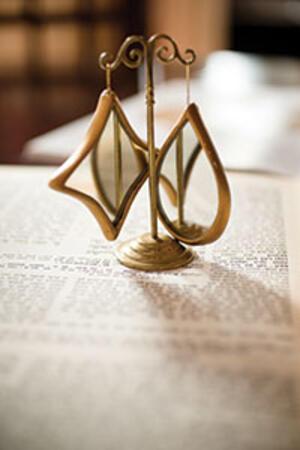Celebrating Passover - Why are there mirrors on this seder table?
Download JWA's 2013 card
Also available in black and white
In 2013, Passover begins with the first seder on the evening of Monday, March 25th. The holiday lasts for eight days.
Because mirrors were vital to the Exodus,
as were the women who carried them.
Rashi, the famous eleventh century commentator, teaches us that mirrors were the tools that the Israelite women used to defy Pharaoh's efforts to annihilate the Israelite people. When the men returned home from their backbreaking labors, they were exhausted and defeated. The women then took out their mirrors and engaged them in a playful game of "who's the fairest of them all." In this way, they lifted their husbands' spirits, aroused their desires, and ensured a future for their people.
The women of the Exodus stared into the face of oppression and refused to bow to it. Their resistance saved the Israelites from extinction.
Ordinary objects can be used to change the course of history. Can you think of other times when ordinary objects have become instruments of protest? Tell us about it.
Other Passover Resources from the Jewish Women's Archive
Why are there mirrors on this seder table?
Download JWA's 2013 card (available in color or black and white) to place on your seder table and spark discussion about resistance and the power of ordinary people to change our world. Learn more about this story from Hillel or Torah.org.
"Including Women's Voices" Haggadah
JWA developed The Wandering Is Over: Including Jewish Women's Voices Haggadah in collaboration with JewishBoston.com. Download a copy, customize, and print in time for your seder!
Miriam and the Passover Story
Watch a short video about Miriam's role in the Passover story.
Jewish Midwives
We often associate the Passover story with Moses and his leadership, but in fact the cycle of protest that culminated in the Exodus from Egypt began with the courageous acts of two women who disobeyed Pharaoh’s decree to murder all male Israelite babies. These women, Shifra and Puah, were midwives. Their commitment to preserving human life and their skills as midwives ensured the safe and secret delivery of Israelite children. Read more about midwives then and now.
Materials for Educators
Living the Legacy: Passover and Jewish Activism
Use the Teaching Exodus 1:1-21 (midwives) text study activity from JWA's social justice education project to explore the connection between Jewish identity and civil disobedience. Discover the sometimes complicated relationship between Jews and African Americans with a lesson about the 1969 Freedom Seder.
Read more about Passover on our blog
Recipes for Passover
Explore our collection of recipes for delicious Passover main dishes, dips and jams, sides, and desserts.
Passover Poetry
Read Studying the Mundane and Holy Terrain, a blog post and poems by Merle Feld.
More stories to tell?
Can you suggest other Passover resources for us to add to this list? How can stories about women upstanders and activists shed new light on our celebration of Passover? Share your thoughts and ideas with us!



